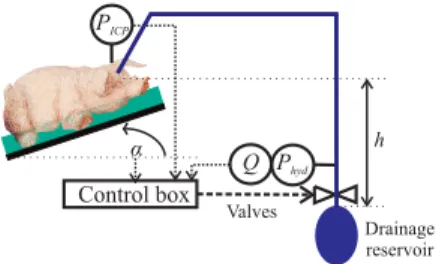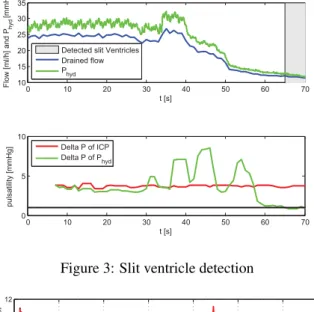FIRST RESULTS OF A NEW ELECTROMECHANICAL CONTROLLED
EXTERNAL VENTRICULAR DRAINAGE IN A PORCINE MODEL
Inga Margrit Elixmann
1, Marian Walter
1, Christine Goffin
1, Michael Czaplik
1, Phil Alexander Huewelmann
1,
Monika Kwiecien
1, Martin Weinzierl
2, Markus Oertel
3, Wolfgang-Ingo Steudel
4, Michael Kiefer
3, Berno
Misgeld
1, Klaus Radermacher
1and Steffen Leonhardt
11
Helmholtz-Institute for Biomedical Engineering, RWTH Aachen University, Aachen, Germany
2,3,4
Department of Neurosurgery:
2Helios Klinikum Krefeld, Germany;
3Inselspital Bern, Switzerland;
4
Saarland University, Homburg, Germany
elixmann@hia.rwth-aachen.de
Abstract: Acute increase of intracranial pressure (ICP) usually has to be treated with an external ventricular drainage (EVD). Current standard mechanical EVD carry a lot of disadvantages, which hypothetically could be bet-ter managed by a newly developed electromechanical EVD. In this report our first preliminary results of such an elec-tromechanical EVD applied in a porcine animal model are presented. The drainage was demonstrated to be both suc-cessful in monitoring and controlling elevated ICP, and able to detect slit ventricles due to overdrainage, if the indented target ICP was set too low.
Keywords: External Ventricular Drainage, Intracranial Pressure, Control, Animal Model
Introduction
An increase in intracranial volume causes raise of intracra-nial pressure (ICP). Such an increase can occur for example because of an imbalance of the continuous process of pro-duction and resorption of cerebrospinal fluid (CSF). Acute high ICP can be life threatening and has to be treated im-mediately. The standard procedure consists of insertion of a pressure sensor for ICP monitoring as well as a catheter into the ventricles for external drainage of CSF. Usually, the height of the CSF drainage reservoir determines the result-ing ICP due to its hydrostatic pressure. This conventional mechanical external ventricular drainage (EVD) has poten-tial disadvantages and possiblities of complications. If the position of the reservoir is chosen too low or the patient changes to an upright position, undesirable overdrainage may occur. The ventricles can collapse to slit ventricles and occlude the catheter perforation. Currently, there is exclu-sively one commercially available electromechanical EVD consisting of an ICP sensor integrated in the drainage tube followed by a peristaltic pump called Liquoguard®(Moeller Medical GmbH), which is conceived of potentially mini-mize these problems. However, it is advisable to use this system with an additional independent ICP sensor to be able to detect slit ventricles. If slit ventricles occur, the integrated pressure sensor measures incorrect ICP values [1]. Therefore, the authors developed an innovative elec-tromechanical "intelligent" EVD (iEVD) [2], which mea-sures simultaneously ICP, pressure and flow in the tube and
h Control box α Phyd PICP Q Valves Drainage reservoir
Figure 1: Experimental setup with the iEVD
patient position α (Figure 1). The iEVD functions by a hydrostatic pressure difference between cranium and CSF drainage reservoir and controls the ICP by positioning of a tube squeezer valve and an additional switching valve. It was already tested in an animal experiment, is able to re-sponse to changes of the drainage reservoir position or tar-get ICP value and can indirectly detect slit ventricles.
Methods
In the present animal experiment, inducing a kaolin solution into the cisterna magna reduces the pigs’s CSF resorption surface. The pig was kept under general anaesthesia. On the third day, the iEVD was implanted and tested.
The control loop with the iEVD is shown in Figure 2. The gradual tube squeezer valve sets an appropriate operating point for the system by adjusting the drainage to the target flow Qtargetand the switching valve was used in the outer
control loop to keep ICP at the intended level. In recent studies, the position of the gradual tube squeezer valve was the only control variable applied. However, due to an in-tegrative error in the position sensor of the tube squeezer valve, the nonlinear relationship of motor position to hy-draulic resistance could not be compensated exactly after some time [2] and hence the switching valve was added. A filter uses a 5 s moving window over 100 Hz ICP measure-ments, determines the maximum (systolic) and minimum (diastolic) ICP value and calculates the average 1 Hz-ICP value by the following equation:
ICP = 1
3(ICPmax+ 2 · ICPmin) (1)
The control algorithm works with a sample frequency of 1 Hz. At the beginning, the switching valve opens and the
following tube squeezer valve gradually opens in minimal step size of 2.5 µm until the iEVD drains a predetermined target flow Qtarget. After this initialization the switching
valve is controlled with a hysteresis of 0.3 mmHg. While the switching valve is open, a secondary controller increases
the stored value of Qtarget by 50 % if ICP is increasing
more than 0.3 mmHg within 1 s or ICP is not decreasing after a certain threshold time.
Whenever QEV D< 1.25 · Qtarget, the controller increases
stepwise the opening position of the tube squeezer valve until Qtargetis reached.
Slit ventricles are diagnosed when pulsation of the brain is not passed on to the water column and the difference of the maximal and minimal value within a 5 s window of 100 Hz data of the pressure sensor in the drainage tube is smaller or equal to 1 mmHg.
Results
The target ICP had to be chosen higher than 8 mmHg other-wise the pig suffered from slit ventricles (s. Figure 3). With a target ICP of 8 mmHg, slit ventricles occured at approx-imately t =50 s and at t =56 s the pulsation in the water
column Phyd got smaller than 1 mmHg and slit ventricles
were identified. The compliance of the tubing dampens the amplitude of ICP by 25 %.
With a higher target ICP the drainage functioned well as shown in Figure 4. At t =110 s the level of the drainage reservoir was increased and the flow decreased. At t =300 s the target ICP was decreased from 10.5 mmHg to 10 mmHg and hence Qtargetwas increased by the controller to drain
sufficently. The tube squeezer valve gradually opened the tube until Qtargetwas reached again. After ∆t ≈200 s the
target flow was constant and only the outer control loop was active once again.
Discussion
First tests of the iEVD at a pig were successful. Potential fu-ture improvements could be an automatic increase of target pressure, if slit ventricles were detected. This preliminary iEVD can serve as a platform for more advanced control approaches: Foltz et al. [3] found out that the waveform is more reliable than mean ICP for diagnosis in humans.
PICP - switching valveController for GS
ΔQProd Controlled system e d‘ ΔP -hΔPh0 d TS Sampler Descretizer filter TS Sampler Descretizer Qdrain Controller for gradual
tube squeezer valve P ICP target valve position NLR NLR = non linear controller (event based control)
Figure 2: ICP control loop
0 10 20 30 40 50 60 70 10 15 20 25 30 35 t [s] Flow [ml/h] and P hyd [mmHg]
Detected slit Ventricles Drained flow P hyd 0 10 20 30 40 50 60 70 0 5 10 t [s] pulsatility [mmHg] Delta P of ICP Delta P of P hyd
Figure 3: Slit ventricle detection
0 100 200 300 400 500 600 700 9 10 11 12 t [s] ICP [mmHg] 0 100 200 300 400 500 600 700 0 10 20 t [s] Flow [ml/h] Measured flow Target flow Drainage bag rise
Figure 4: Measured adaption of target flow to maintain the changing target ICP at t =300 s
If pigs show similar single pulse waveform change follow-ing increasfollow-ing ICP, it would be possible to observe how the iEVD performs in draining according to waveform.
Acknowledgement
The authors express their gratitude for the financial sup-port of the BMBF, the supsup-port of Sensirion AG and of our project partner Reco Medizintechnik Wolfgang Rentsch e.K. and Raumedic AG.
Bibliography
[1] S. Linsler, M. Schmidtke, W. I. Steudel, M. Kiefer, and J. Oertel, “Automated intracranial pressure-controlled cerebrospinal fluid external drainage with Liquo-Guard®,” Acta Neurochir (Wien), Nov. 2012, Epub. [2] I. M. Elixmann, M. Walter, C. Goffin, S. Hahne,
M. Kiefer, and S. Leonhardt, “Hirndruckmodellierung und Regelung einer neuen mechatronischen exter-nen Ventrikeldrainage,” at - Automatisierungstechnik, vol. 59, pp. 613–621, Oct. 2011.
[3] E. L. Foltz and C. Aine, “Diagnosis of hydrocephalus by CSF pulse-wave analysis: a clinical study.,” Surg Neurol, vol. 15, pp. 283–93, Apr. 1981.

